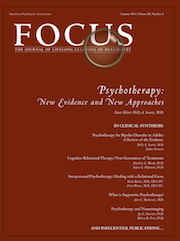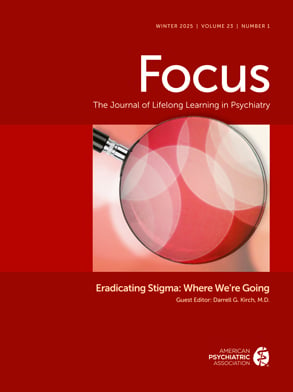What is supportive psychotherapy? The term has been widely used, poorly and variously defined, and often disparaged. It can mean anything and nothing; yet also, when carefully defined and applied, it can describe a potent treatment that (I will argue) lies at the core of all good psychotherapy. So, supportive psychotherapy deserves clinical attention. This article briefly reviews the history and meaning of “supportive psychotherapy” (SP), its clinical and research use, and then suggests a research-tested definition of SP for general usage.
Definitions
The original definition of SP was, essentially, second-rate therapy for second-rate patients. During the heyday of psychoanalysis, the goal was to treat analyzable patients with psychoanalysis. Psychotherapists then faced the problem of unanalyzable patients: those without the reflective capacity to hear interpretations, or with “pseudoneurotic schizophrenia” (
2), who appeared analyzable but then unraveled on the couch. These patients ended up receiving a more bolstering, “supportive” treatment while sitting upright, in which less distant (less “neutral”) therapists shored up defenses and eschewed interpretation. This unpsychoanalysis for the unanalyzable was not the preferred mode of treatment, not for the preferred patients, and hence, from its onset, had a pejorative edge.
As supportive psychotherapy was negatively defined as not-psychoanalysis, it became an umbrella term for every form of psychotherapy other than psychoanalysis itself. All evidence-based therapies, such as cognitive-behavioral therapy (CBT) and interpersonal psychotherapy (IPT), technically fall under the rubric. Yet so stretched a denotation renders the term meaningless, particularly in the current era where few patients actually receive psychoanalysis. The Wikipedia definition: “Supportive psychotherapy is a psychotherapeutic approach that integrates psychodynamic, cognitive-behavioral, and interpersonal conceptual models and techniques” (
3) is unhelpful and wrongheaded. Some clinicians, perhaps influenced by the term “supportive,” seem to view SP as handholding by social workers, i.e., being nice to patients. That description, too, seems inadequate and unfair.
Other clinicians and researchers (
4–
9) have attempted to define SP more positively and meaningfully, although this still has produced somewhat diffuse and at times contradictory definitions. The type of SP may vary with the diagnoses of a target treatment population (e.g., psychotic versus nonpsychotic) or with the theoretical orientation of its proponents. It may have underlying psychodynamic roots (shoring up adaptive defenses) or not.
Clinical Use of Supportive Psychotherapy
Surveys of clinicians have led to claims that supportive psychotherapy is the most widely used of psychotherapeutic interventions. For example, the 1998 National Survey of Psychiatric Practice found that psychiatrists treated 36% of patients with SP, 19% with insight-oriented therapy, 6% with CBT, and 1% with psychoanalysis (
10). Yet what does this mean? Clinicians are not always specific in defining their interventions (many will say that they “do” CBT or IPT despite lacking relevant training), and the broad (lack of) definition of SP may have lumped diverse approaches in specious unity. Further, practice patterns may have changed considerably in the past 15 years since that survey. Nonetheless, a lot of clinicians believe they are conducting supportive psychotherapy with their patients.
My impression as a supervisor of residents and of clinicians in practice is that many therapists treat patients with what they believe is supportive psychotherapy for no particular indication, following no guideline. Rather than working from a diagnostic assessment to consideration of evidence-based treatments for a target syndrome, they fall into treating the patient “supportively”: a somewhat indeterminate approach encompassing various techniques. In this setting, supportive therapy becomes a synonym for eclectic therapy, perhaps partly bolstering the Wikipedia definition. (Such an approach does not “integrate” different techniques, however, it merely mixes them.)
Research on Supportive Psychotherapy
Supportive psychotherapy has rarely been studied as the primary treatment for anything (
11). It has instead provided the foil to fancier treatments, appearing in numerous studies as a comparator or control. Supportive therapists in research trials have rarely been handpicked: they have often been less allegiant and less convinced of its efficacy than of the opposing condition (
12). Douglas asserted, “supportive therapy has not been sufficiently well defined in a manual or tested in controlled clinical trials to be considered evidence based” (
9, p. 450). Yet given its lack of researcher allegiance (
13,
14) and likely therapist allegiance (
12), factors that have been shown to influence study outcome, supportive psychotherapy has fared remarkably well. Too often, researchers favoring another brand name of psychotherapy have been frustrated by a “dead heat” outcome, in which SP has done just as well as the touted experimental treatment.
To cite just a few of many possible examples: a randomized study comparing Kernberg’s Transference-Focused Psychotherapy, Linehan’s Dialectical Behavioral Therapy, and supportive psychotherapy for 90 patients with borderline personality disorder found no clear differential outcome among treatments (
15). A large trial (N=491) comparing highly favored Cognitive Behavioral Analysis System of Psychotherapy (CBASP), a therapy specifically designed to treat chronic depression, to supportive psychotherapy as adjuncts to a pharmacotherapy algorithm for treatment resistant, chronically depressed patients showed no difference between treatments (
16). (Neither type of psychotherapy produced better results than pharmacotherapy alone.) In a 16-week study of 94 dysthymic patients, SP equaled IPT in treatment effect (
17). For depressed HIV-positive patients, SP matched CBT in benefit despite having fewer treatment sessions (
18). Supportive psychotherapy worked as well as brief dynamic psychotherapy in a study of Cluster C personality disorders (
19).
Such findings suggest that SP is active, efficacious, and often achieves lasting, meaningful results (
11). In comparison to more grueling exposure-based treatments for anxiety disorders, such as posttraumatic stress disorder (PTSD), SP has had a lower dropout rate (
20). Indeed, its potency led Hellerstein and colleagues to declare “supportive therapy as the treatment model of choice” for many patients (
21). A recent meta-analysis of 31 randomized trials supports this assertion. Cuijpers et al. (
22) found nondirective supportive therapy (NDST) effective in treating depression in adults, with no differences relative to other psychotherapies after controlling for researcher allegiance. The meta-analysts concluded that NDST “has a considerable effect on symptoms of depression” (
22).
Similarly, Wampold has shown the difficulty in finding differences between any two credible, reasonably well delivered psychotherapies matched for time and therapist experience (
23). Supportive psychotherapy has impressed me over the years as a worthy treatment. A treatment study that shows a rival treatment surpassing supportive therapy passes a much tougher test than one compared with a waiting list condition. Supportive psychotherapy works.
How and Why Does it Work?
In the course of a research career involving psychotherapy outcome studies, I have considerable experience with supportive psychotherapy. Dr. Michael Sacks and I have co-written an unpublished manual of supportive psychotherapy that several researchers have used in multiple outcome studies. This defined, time-limited form of brief supportive psychotherapy (BSP) has fared well in treatment trials––again, sometimes better than the investigators allegiant to other therapies might have wished (
16–
18,
24,
25).
This version of brief supportive psychotherapy consists of an affect-focused, “common factors” approach to treatment. Its roots derive from the Client-Centered Therapy of Carl Rogers (
4). The common factors, outlined by master psychotherapists like Jerome Frank (
5,
6), earned that term because such factors are believed common and crucial to all psychotherapies (see
Table 1). Most “common factors” appear good therapeutic common sense. Nondirective, except in the therapist’s pursuit of the patient’s affect, BSP allows the patient to set the course of treatment. Like Rogers, the therapist listens carefully and reflects back affect to the patient with careful clarifications. This builds the therapeutic alliance, which correlates with treatment outcome (e.g.,
23,
26). BSP helps many patients to develop a new vocabulary for their emotions, recognizing that “upset” can variously mean sad, anxious, or angry. This kind of therapy may sound easy, but it is hard to do well, particularly when a negative affect emerges that may make both the therapist and patient uncomfortable (
27). Yet gaining comfort with one’s emotions adds a dimension to life and a new understanding of one’s world. To quote Frank: “[T]he task of the therapist––whatever his or her technique––is to clarify symptoms and problems, inspire hope, facilitate experiences of success or mastery, and stir the patient’s emotions. …[T]he main effect of such activity is to alleviate the patients’ sense of powerlessness to change themselves or their environment, a condition that may be termed
demoralization” (
6, pp. xiii–xiv).
Unlike many other evidence-based therapies, BSP offers the patient no overarching explanation for his or her disorder or why the treatment will work. The therapist may underscore the importance of understanding one’s emotions. It assigns no homework, conferring the advantage that the patient cannot fail to do the homework and end up feeling like a bad patient. We have included a little psychoeducation about the target disorder, but there is no attempt to weigh the evidence of cognitions, role-play interpersonal scenarios, or to get the patient to “do” anything more than reflect on his or her emotions. In some respects, then, BSP is an elemental, pure therapy, psychotherapy stripped down to its basics.
Table 2 provides a listing of “do’s and don’ts” for BSP. It should clarify that BSP is the inverse of the Wikipedia definition: the core of psychotherapy without the bells and whistles of psychodynamic, IPT, or CBT therapies. Our research has shown that therapists can adhere to BSP (
28).
Table 3 lists some of the adherence items that help to define good BSP therapy. Wampold (
23) and others have shown that such “common factors” account for about half of the total variance of psychotherapy outcome, whereas the added interventions that define CBT, IPT, DBT, and the rest account for only another 10%−15%. Cuijpers et al. (
22) in their meta-analysis found that “most of the effect of therapy for adult depression is realized by non-specific factors, and our results suggest that the contribution of specific effects is limited at best.”
These common factors help build a treatment alliance necessary for effective pharmacotherapy as well (
29). Thus, in training BSP therapists, I have offered them a paradoxical therapeutic challenge:
First: if you cannot do this, the rest of psychotherapy does not matter. Delivering the common factors well is the sine qua non of all treatment. You will not be able to deliver the specific techniques of CBT or the pills of pharmacotherapy if you cannot make a strong alliance.
Second: if you can do this, the rest of psychotherapy does not matter. The bulk of what you can provide, you are already providing.
Therapists trained in this BSP approach who come from other schools of psychotherapy, such as CBT, may initially feel de-skilled, stripped of their usual interventions, forced to listen more, and to let the patient lead. Some previously thought they knew supportive therapy until they came to it. In our trials, many therapists came to appreciate the approach, and some converted to a supportive therapy stance in their outside practices (
30).
Patients entering the multisite research evaluating the value of augmenting medication with psychotherapy (REVAMP) study of chronic treatment-resistant depression (
16) probably were not seeking BSP. They either wanted the medication algorithm that all patients received, or else the depression-focused CBASP treatment. BSP was the obvious control condition. Many patients had never received psychotherapy before, were unsure what to make of it, and initially reluctant to try it. Yet many ultimately felt liberated by the chance to talk about their feelings and lives in a new way, and even patients who did not ultimately respond on depression scales appreciated the treatment (
30).

